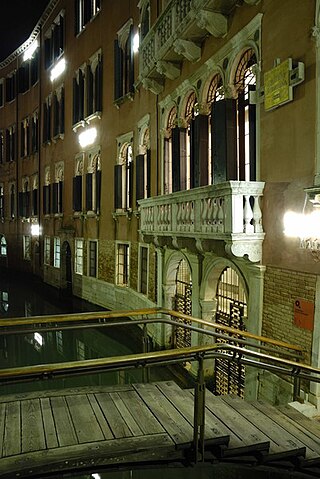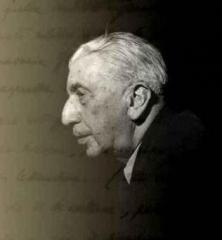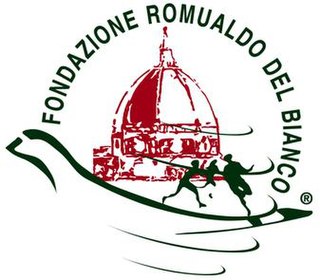
Pietro Longhi was a Venetian painter of contemporary genre scenes of life.

The National Roman Museum is a museum, with several branches in separate buildings throughout the city of Rome, Italy. It shows exhibits from the pre- and early history of Rome, with a focus on archaeological findings from the period of Ancient Rome.

The Fondazione Querini Stampalia is a cultural institution in Venice, Italy, founded in 1869 at the behest of the last descendant of the Venetian Querini Stampalia family, Conte Giovanni Querini. Architect Carlo Scarpa designed interior, exterior, and garden elements and spaces on the ground floor of the historic building.

The Museo Correr is a museum in Venice, northern Italy. Located in St. Mark's Square, Venice, it is one of the 11 civic museums run by the Fondazione Musei Civici di Venezia. The museum extends along the southside of the square on the upper floors of the Procuratorie Nuove. With its rich and varied collections, the Museo Correr covers both the art and history of Venice.

Roberto Capucci is an Italian fashion designer.

Roberto Longhi was an Italian academic, art historian, and curator. The main subjects of his studies were the painters Caravaggio and Piero della Francesca.

Federico Zeri was an Italian art historian specialised in Italian Renaissance painting. He wrote for the Italian newspaper La Stampa, and was a well known television-personality in Italy.
Richard Christian Wynne Fremantle was an American art historian. The focus of most of his work is the early Florentine Renaissance, and in particular, the painter Masaccio.

Ettore Tito was an Italian artist particularly known for his paintings of contemporary life and landscapes in Venice and the surrounding region. He trained at the Accademia di Belle Arti in Venice and from 1894 to 1927 was the Professor of Painting there. Tito exhibited widely and was awarded the Grand Prize in painting at the 1915 Panama–Pacific International Exposition in San Francisco. In 1926 he was made a member of the Royal Academy of Italy. Tito was born in Castellammare di Stabia in the province of Naples and died in Venice, the city which was his home for most of his life.
Louis Alexander Waldman is an American art historian and author specializing in the Italian Renaissance.
The Dena Foundation for Contemporary Art (DFCA) is an American non-profit organization that promotes contemporary visual arts and young artists in that field.

Scuola romana or Scuola di via Cavour was a 20th-century art movement defined by a group of painters within Expressionism and active in Rome between 1928 and 1945, and with a second phase in the mid-1950s.

Antonietta Raphaël was an Italian sculptor and painter of Jewish heritage and Lithuanian birth, who founded the Scuola Romana movement together with her husband Mario Mafai. She was an artist characterised by a profound anti-academic conviction, also affirmed by her sculptures which, especially after World War II, dominated her output. They highlighted the tender and vibrant carnality present in stone, with works such as Miriam dormiente and Nemesis.

The Romualdo Del Bianco Foundation is an Italian non-profit organization established in Florence, Italy, on November 3, 1998, by Paolo Del Bianco - who entitled the Foundation to his father Romualdo. The Foundation is funded privately by Paolo Del Bianco. The Foundation promotes tourism awareness and dialogue between cultures. At the moment, the Foundation network counts over 450 academic institutions and universities in 60 countries in 5 continents.

Francesco Bonami is an Italian art curator and writer who is currently Honorary Director of Fondazione Sandretto Re Rebaudengo in Turin. He lives in Milan and Manhattan, New York.

Maurizio Nannucci is an Italian contemporary artist. Lives and works in Florence and South Baden, Germany. Nannucci's work includes: photography, video, neon installations, sound installation, artist's books, and editions. Since the mid-sixties he is a protagonist of international artistic experimentation in Concrete Poetry and Conceptual Art.

Portrait of a Knight of Malta is a c.1515 oil on canvas painting by Titian of a knight belonging to the Order of Malta. It is now in the Uffizi in Florence. The last bead of the rosary held by the knight bears the number XXXV (35), showing the subject's age at the time of the portrait. W.F. Dickes. argued that he was Stefano Colonna, the condottiero who led the republican resistance during the siege of Florence. cited in
The Life of Christ is a series of five paintings in tempera and gold on panel depicting scenes from the Life of Christ and the Last Judgement. The works date to around 1290–1300 and are attributed to the circle of Cimabue or to a Venetian artist. They are now in various museums and private collections: the Longhi Foundation in Florence, the New Orleans Museum of Art, the Portland Art Museum, the Pedralbes Monastery near Barcelona and a private collection in Milan.

Federica Galli was an Italian figurative artist known for her etchings. Her work depicts the landscapes and architecture of the Po valley, the Alps, the Mediterranean coast, Milan, and Venice, with a particular focus on the trees occupying these environments.

Giancarlo Tognoni .Giancarlo Tognoni was an Italian painter, engraver and sculptor. He was born in Pisa, but continued his studies in Florence, where he attended the art institute of the Tuscan capital. As soon as he graduated, he began his activity as a sculptor and ceramist, then coming to learn the various engraving techniques such as drypoint and etching, which will lead him to be considered one of the most important artists of Italian and foreign engravering art. Towards the end of the 1950s, he lived for some time in Paris, where he met Alberto Magnelli and Gino Severini and where, in particular, he could admire artists such as Jean Fautrier and Hartung. It is in this period, which will mark a transitory but significant season, that Tognoni approaches sign and material painting. At the beginning of the 1960s, he moved to Milan, where he began to attend the artistic circles of the city, spending most of his days at the "Spirale", the famous art printing house. It is here that Tognoni meets Giuseppe Ajmone and Franco Russoli, with whom he will benefit form a strong friendship. The one with Franco Russoli, director of the Brera Art Gallery, will be a very important partnership, as will put Tognoni in contact with the main artists of the moment, such as Piero Manzoni and Lucio Fontana and will encourage him to participate in many of the most important national and international exhibitions and reviews. This is how the first significant successes and recognitions arrive, testimonies that will accompany him later, in his intense activity, both as a painter and as an engraver, but despite which, Tognoni will remain a secluded artist, out of the big spotlights, gathered in his own creativity, as well as study and experimentation. Many of the major Italian and international critics have written about him. His works are found in public and private collections: Florence, Gabinetto disegni e stampe degli Uffizi; Vienna, Accademia Albertina; Paris, special collections of the Bibliothèque nationale de France; Pisa, Department of History of Arts, University of Pisa "Collezione Timpano"; Barcelona, Fundació Joan Miró; Milan, Musei del Castello Sforzesco, collection "A. Bertelli"; Venice, International Gallery of Modern Art Ca'Pesaro; Washington, D.C., National Gallery of Art; Pisa, Scuola Normale Superiore di Pisa Puteano palace; Lucca, National Museum of Villa Guinigi; Batavia, Illinois, Fermilab; Turin,Fondazione per la Scuola "Educatorio Duchessa Isabella della Compagnia di San Paolo"; Monaco, Staatliche Graphische Sammlung München; Oderzo, Foundation Alberto Martini; Bagnacavallo, Graphics National Center; Carrara Accademia di Belle Arti; Trieste, Revoltella Museum.

















